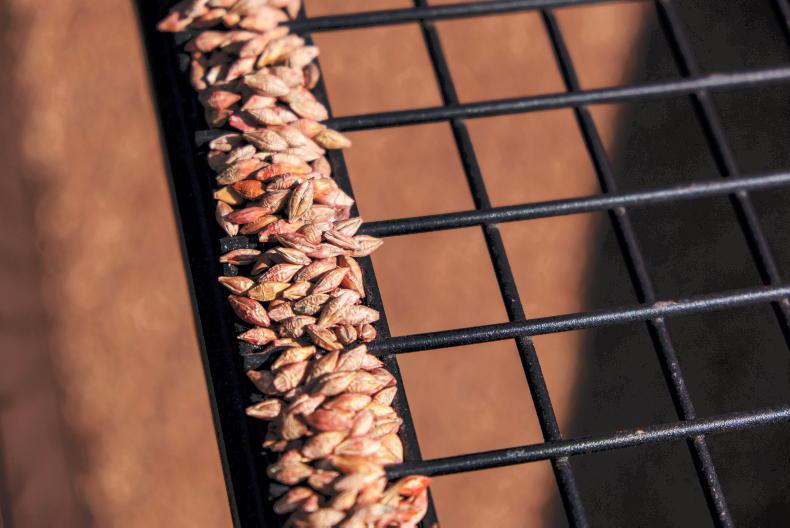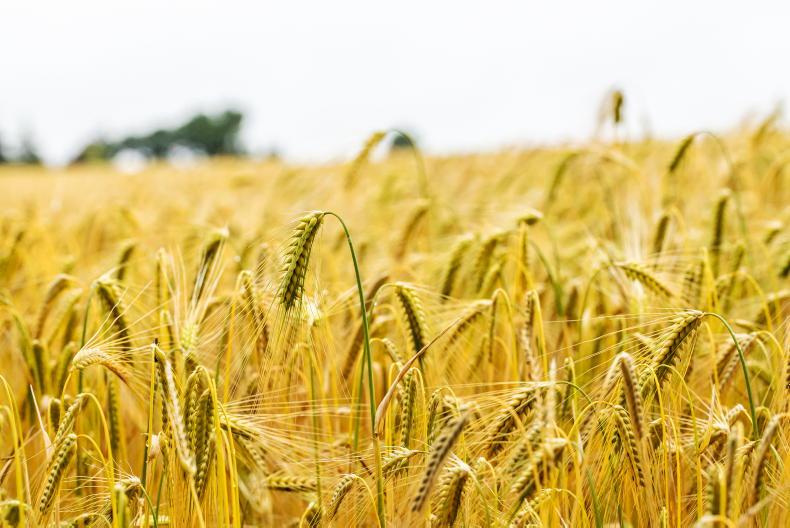Ireland’s seed production industry represents a valuable premium market for many growers.
Each year, around 45,000t of certified seed is produced for the Irish market.
The process of producing and certifying this seed is a long and rigorous one and deserves further explaining.
In addition to this, the challenge of securing suitable land to produce high-grade seed is becoming ever more difficult, as this article explains.
Why Irish certified seed?
Ireland has one of the most robust seed certification systems in Europe. The seed certification system is an official system supported by EU and national legislation, along with international protocols.
Ireland has an independent certified seed scheme operated by the Department of Agriculture, Food and the Marine, where Irish crops must adhere to a higher standard of seed purity and weed control.
The immediate objective of the seed certification system is to provide a guarantee to the customer that the seed is true to identity, high in purity and germination capacity, and free from major pests and diseases.
Irish certified seed is of premium quality due to its voluntary standards which are considerably higher than those of EU directives.

Ireland has one of the most robust seed certification systems in Europe.
The tolerance level of the purity of variety for C1 (commercial seed) in Ireland is set at 99.9%. This is higher than the standard of imported seed, which is predominantly C2.
This voluntary standard also includes higher weed and disease tolerance levels of Irish certified seed.
For example, sterile brome and blackgrass tolerance levels are set at zero in Ireland, while in some cases imported seed has tolerance levels of 10, posing a risk to Irish growers.
Growers and ground
Producing C1 seed relies on a high level of attention to detail by dedicated seed growers but is also dependent on access to suitable ground.
This is an ongoing challenge for seed merchants and multipliers.
Ground which is suitable for producing C1 seed must comply with a number of strict criteria.

Irish certified seed is of premium quality due to its high voluntary standards.
High weed and volunteer hygiene is arguably one of the most important. Seed crops should not be grown in fields known to be infested with wild oats or other invasive weeds or where straw or first-year hay was fed to livestock in the previous season.
The grower must take responsibility to rogue impurities such as weeds and volunteers from the crop where levels are not within the standards set out by the Department. This means that a significant time commitment is involved in walking crops throughout the season, to ensure that no contamination of the final seed crop occurs.
Contaminated crops will not be passed for seed. The use of glyphosate on any seed crops is also banned.
Seed crops may be grown after break crops in a specified rotation agreed with the Department to help control weeds and volunteers.
Suitable break crops include ley ground, beet, potatoes, maize, kale/turnips and winter oilseed rape.
In addition to this, there are strict requirements when growing seed crops next to other cereal crops.
A physical barrier such as a continuous hedge, ditch, fence or road, or 2m of a non-cereal crop or clean fallow ground between the seed crop and another cereal crop is required.
In addition to this, if more than one-third of the seed crop is lodged at the time of inspection the crop will be rejected.

While all growers must be particularly conscious of the need for thorough cleaning of machinery between fields and crop to ensure invasive weeds are controlled, for seed growers the level of cleaning which is required is significant. This applies to all machinery used from the drill through to the combine, trailers, tractors and storage areas if they apply.
Being a grower of certified seed means having a close relationship with merchants who have contracted the growing of the crop, as well as the Department which certifies the crop.
Once the contract is signed with the grower, basic seed is delivered on the farm.
After drilling, the field is subject to several inspections by the Department and before harvest, green seed is sampled and checked for purity and quality.
Fourteen stages
Once passed and harvested, the seed passes through 14 stages before finishing the process.
1 Each seed lot is segregated into separate silos at the merchant’s yard.
2 The grain is pre-cleaned and carefully dried to 14% moisture content. The dryers and conveyors are cleaned between different varieties.
3 The seed grain is stored and aerated in silos/stores.
4 Samples of dried seed are then tested by the Department for:
Germination and purity. Seed-borne diseases.5 A pre-advisory report on each seed lot is issued by the Department.
6 Acceptable seed is now ready for bagging/certification.
7 The seed is cleaned of weed seeds, small grains, screenings, etc.
8 An appropriate chemical dressing is applied.
9 The seed is weighed and packed with a Department label.
10 A sample of each seed lot is again tested by the Department.
11 A final seed-lot test report is issued by the Department.
12 Certified Blue Label (C1) seed is then ready for delivery to Irish farmers.
13 A sample of each seed lot is sown in “post-control” plots at Backweston, Co Kildare.
14 Certified seed sales must be reported to the Plant Variety Development Office and royalties are paid to the plant breeders.
The Irish Seed Trade Association (ISTA) represents multipliers, producers and distributors of certified seed in Ireland and promotes the use of certified seed in tillage, forage and grassland crops.
With close collaboration between ISTA, the Department of Agriculture and Teagasc, efforts are focused on promoting native certified seed suitable for Irish conditions and making growers aware of the benefits of using certified seed above sub-standard alternatives.
Brendan O’Gorman is a cereal seed grower from Castletownroche, Co Cork. The Irish Farmers Journal recently caught up with Brendan who has over 30 years’ experience growing cereal seed.

Brendan has been growing seed crops for over 30 years
Around 75% of his cropped area is in winter and spring barley seed, mostly grown for Goldcrop.
Weed hygiene
He says that growing seed works well for him as he generally practises a high level of weed hygiene on his farm.
“We try to keep the farm as clean as we can and growing seed really gives us an incentive to do this,” he said.
Attention to detail is key. From spring onwards, Brendan walks his seed crops weekly to ensure they remain weed-free. If weeds do appear, then they must be hand-rogued, he says.
Often, weed control starts before the seed crop is sown. He generally tries to grow his first seed crops following maize.
He says he would walk his maize crops to ensure that no grassweeds were present, which could cause a problem for the following year’s seed crop.
Brendan works with a local contractor who takes great care to clean his machinery before harvesting the seed crops.
They also cut a few tonnes of the crop when starting the harvest to flush the combine. This flushed grain is sent for feed.
These practices are not only important for ensuring varietal purity but also help to minimise the risk of weed seed spread.
Challenges
While growing seed works well for Brendan’s business, the challenge of controlling grassweeds is becoming increasingly difficult.
Wild oats isn’t a big problem on his farm but he notices increasing numbers of sterile brome and canary grass.
He also notes that the ever reducing pool of chemistry available to growers and the increasing risk of herbicide resistance is adding to the challenge of growing clean seed crops.
Ireland’s seed production industry represents a valuable premium market for many growers.
Each year, around 45,000t of certified seed is produced for the Irish market.
The process of producing and certifying this seed is a long and rigorous one and deserves further explaining.
In addition to this, the challenge of securing suitable land to produce high-grade seed is becoming ever more difficult, as this article explains.
Why Irish certified seed?
Ireland has one of the most robust seed certification systems in Europe. The seed certification system is an official system supported by EU and national legislation, along with international protocols.
Ireland has an independent certified seed scheme operated by the Department of Agriculture, Food and the Marine, where Irish crops must adhere to a higher standard of seed purity and weed control.
The immediate objective of the seed certification system is to provide a guarantee to the customer that the seed is true to identity, high in purity and germination capacity, and free from major pests and diseases.
Irish certified seed is of premium quality due to its voluntary standards which are considerably higher than those of EU directives.

Ireland has one of the most robust seed certification systems in Europe.
The tolerance level of the purity of variety for C1 (commercial seed) in Ireland is set at 99.9%. This is higher than the standard of imported seed, which is predominantly C2.
This voluntary standard also includes higher weed and disease tolerance levels of Irish certified seed.
For example, sterile brome and blackgrass tolerance levels are set at zero in Ireland, while in some cases imported seed has tolerance levels of 10, posing a risk to Irish growers.
Growers and ground
Producing C1 seed relies on a high level of attention to detail by dedicated seed growers but is also dependent on access to suitable ground.
This is an ongoing challenge for seed merchants and multipliers.
Ground which is suitable for producing C1 seed must comply with a number of strict criteria.

Irish certified seed is of premium quality due to its high voluntary standards.
High weed and volunteer hygiene is arguably one of the most important. Seed crops should not be grown in fields known to be infested with wild oats or other invasive weeds or where straw or first-year hay was fed to livestock in the previous season.
The grower must take responsibility to rogue impurities such as weeds and volunteers from the crop where levels are not within the standards set out by the Department. This means that a significant time commitment is involved in walking crops throughout the season, to ensure that no contamination of the final seed crop occurs.
Contaminated crops will not be passed for seed. The use of glyphosate on any seed crops is also banned.
Seed crops may be grown after break crops in a specified rotation agreed with the Department to help control weeds and volunteers.
Suitable break crops include ley ground, beet, potatoes, maize, kale/turnips and winter oilseed rape.
In addition to this, there are strict requirements when growing seed crops next to other cereal crops.
A physical barrier such as a continuous hedge, ditch, fence or road, or 2m of a non-cereal crop or clean fallow ground between the seed crop and another cereal crop is required.
In addition to this, if more than one-third of the seed crop is lodged at the time of inspection the crop will be rejected.

While all growers must be particularly conscious of the need for thorough cleaning of machinery between fields and crop to ensure invasive weeds are controlled, for seed growers the level of cleaning which is required is significant. This applies to all machinery used from the drill through to the combine, trailers, tractors and storage areas if they apply.
Being a grower of certified seed means having a close relationship with merchants who have contracted the growing of the crop, as well as the Department which certifies the crop.
Once the contract is signed with the grower, basic seed is delivered on the farm.
After drilling, the field is subject to several inspections by the Department and before harvest, green seed is sampled and checked for purity and quality.
Fourteen stages
Once passed and harvested, the seed passes through 14 stages before finishing the process.
1 Each seed lot is segregated into separate silos at the merchant’s yard.
2 The grain is pre-cleaned and carefully dried to 14% moisture content. The dryers and conveyors are cleaned between different varieties.
3 The seed grain is stored and aerated in silos/stores.
4 Samples of dried seed are then tested by the Department for:
Germination and purity. Seed-borne diseases.5 A pre-advisory report on each seed lot is issued by the Department.
6 Acceptable seed is now ready for bagging/certification.
7 The seed is cleaned of weed seeds, small grains, screenings, etc.
8 An appropriate chemical dressing is applied.
9 The seed is weighed and packed with a Department label.
10 A sample of each seed lot is again tested by the Department.
11 A final seed-lot test report is issued by the Department.
12 Certified Blue Label (C1) seed is then ready for delivery to Irish farmers.
13 A sample of each seed lot is sown in “post-control” plots at Backweston, Co Kildare.
14 Certified seed sales must be reported to the Plant Variety Development Office and royalties are paid to the plant breeders.
The Irish Seed Trade Association (ISTA) represents multipliers, producers and distributors of certified seed in Ireland and promotes the use of certified seed in tillage, forage and grassland crops.
With close collaboration between ISTA, the Department of Agriculture and Teagasc, efforts are focused on promoting native certified seed suitable for Irish conditions and making growers aware of the benefits of using certified seed above sub-standard alternatives.
Brendan O’Gorman is a cereal seed grower from Castletownroche, Co Cork. The Irish Farmers Journal recently caught up with Brendan who has over 30 years’ experience growing cereal seed.

Brendan has been growing seed crops for over 30 years
Around 75% of his cropped area is in winter and spring barley seed, mostly grown for Goldcrop.
Weed hygiene
He says that growing seed works well for him as he generally practises a high level of weed hygiene on his farm.
“We try to keep the farm as clean as we can and growing seed really gives us an incentive to do this,” he said.
Attention to detail is key. From spring onwards, Brendan walks his seed crops weekly to ensure they remain weed-free. If weeds do appear, then they must be hand-rogued, he says.
Often, weed control starts before the seed crop is sown. He generally tries to grow his first seed crops following maize.
He says he would walk his maize crops to ensure that no grassweeds were present, which could cause a problem for the following year’s seed crop.
Brendan works with a local contractor who takes great care to clean his machinery before harvesting the seed crops.
They also cut a few tonnes of the crop when starting the harvest to flush the combine. This flushed grain is sent for feed.
These practices are not only important for ensuring varietal purity but also help to minimise the risk of weed seed spread.
Challenges
While growing seed works well for Brendan’s business, the challenge of controlling grassweeds is becoming increasingly difficult.
Wild oats isn’t a big problem on his farm but he notices increasing numbers of sterile brome and canary grass.
He also notes that the ever reducing pool of chemistry available to growers and the increasing risk of herbicide resistance is adding to the challenge of growing clean seed crops.










 This is a subscriber-only article
This is a subscriber-only article










SHARING OPTIONS: